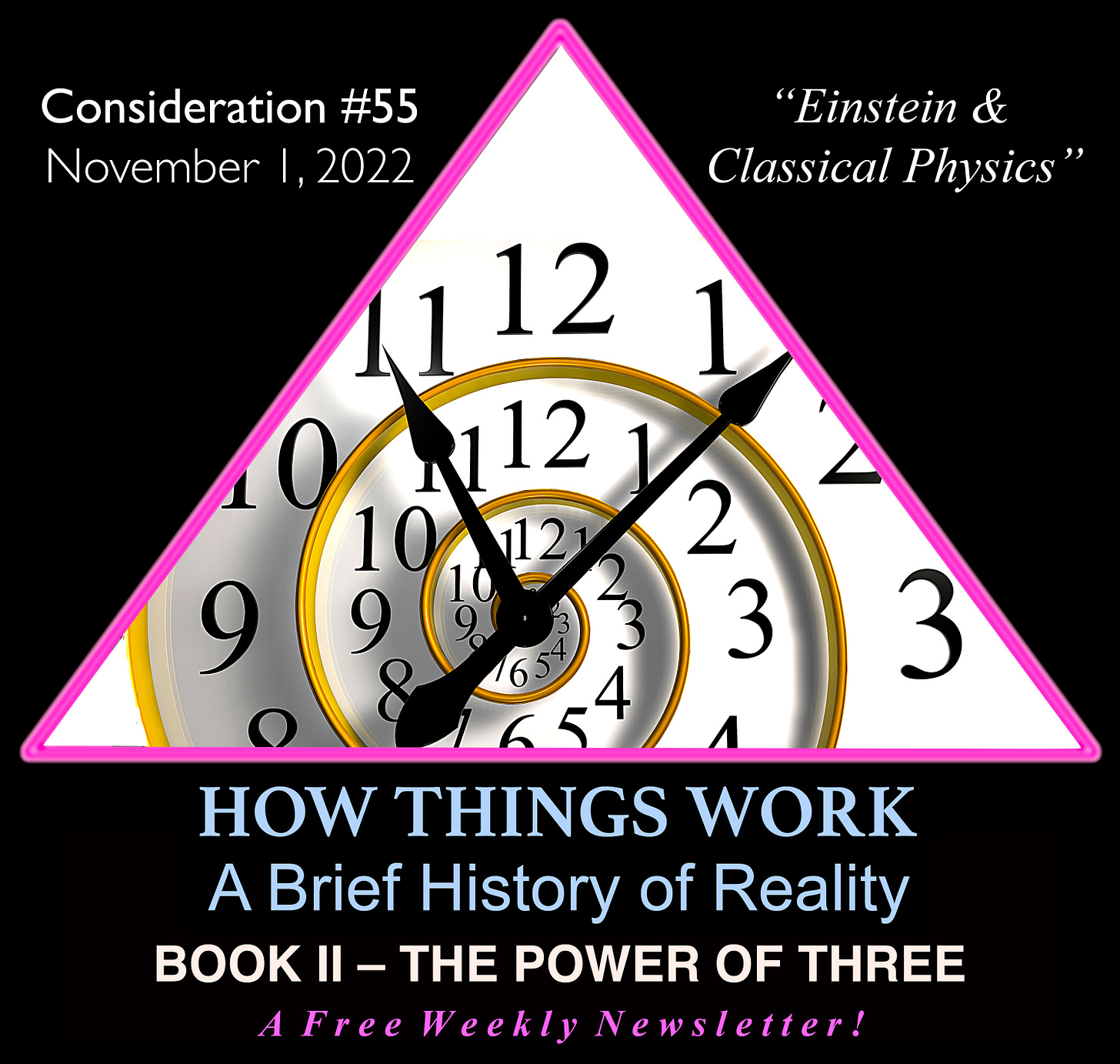How Things Work: A Brief History of Reality
BOOK II: The Power of Three (#55. "Einstein and Classical Physics")
Be A Part of the Conversation!
Tuesday, November 1, 2022
“Time is an illusion.” – Albert Einstein
CONSIDERATION #55 – “Einstein & Classical Physics”
PREFACE
The key to understanding Einstein’s insights about Reality starts with understanding that, at their core, his “ideas” and “theories” about Reality are completely rational concepts. As a way of thoroughly understanding a hypothetical concept or paradox Einstein would immerse himself in what he called “thought experiments.” There, he would “imagine” and “visualize” various rational possibilities related to the problem at hand. It was from this completely “rational” state of conscious awareness that he generated his unique new theories about reality. Amazingly, once he had established a rational foundation of thought for an idea or theory, the math needed to support it was very simple and straightforward.
“This deceptively simple expression that “Energy is Equal to Mass Times the Speed of Light Squared” is a very simple and direct logical statement, with virtually no advanced math required.”
The eventual mathematical expression of Einstein’s Special Theory of Relativity is quite simple: E=mc2. Five abstract characters. Not a volume. Not a book. Not a page. Not even a sentence. This deceptively simple expression that “Energy is Equal to Mass Times the Speed of Light Squared” is a very simple and direct logical statement, with virtually no advanced math required. Yet, it changed our entire understanding of the universe. This is the genius of Einstein. And its source is not Einstein’s mathematics, it’s Einstein’s mind.
CONSIDERATION #55 – Einstein and Classical Relativity
In 1905, Einstein published a paper that would forever change the scientific world, as well as the inherent nature of what had previously been considered reality. Utilizing only high school level mathematics, Einstein’s Special Theory of Relativity proposed that the very foundations of what was once known to be completely certain, including the essential qualities of Time, Space, and Physical Objects, were in fact, completely wrong. Here’s how it works.
Classical Relativity
In classical physics, certain conclusions were considered absolute. For example, classical physics postulated that there was no such thing as absolute motion or absolute rest; all objects move relative to each other. Ironically, the certainty of nothing being absolute was itself considered an absolute certainty. What this really means is that there is no single point, or object, in the universe that serves as a reference for the movement of all other objects in the universe. Everything is already in motion and there is no single reference point from which to gauge other movement, except other movement.
“Ironically, the certainty of nothing being absolute was itself considered an absolute certainty.”
From an Aristotelian perspective, it could be argued that the “Unmoved Mover” is this intangible and unmeasurable reference point. However, as we will see, this type of metaphysical thinking would be relegated to the “lesser” realm of religion. With this in mind, consider the following example of classical relative motion.
Imagine a long flat-bed truck driving down a straight flat highway at a constant speed of 40 miles per hour. On the bed of the truck are two kids playing catch while the truck is moving. The two children are not aware of the truck’s motion as they throw the ball back and forth to each other at ten miles per hour; to them, the ball is only moving 10 miles per hour back and forth.
“…relative to the bystander, the ball is moving 40 miles per hour with the truck plus ten miles per hour when it is thrown in the same direction the truck is moving for a total of 50 miles per hour…”
However, a bystander on the side of the road watching the truck go by would experience the ball as moving at either 30 or 50 miles per hour, depending on which way the ball was being thrown. This is because, relative to the bystander, the ball is moving 40 miles per hour with the truck plus ten miles per hour when it is thrown in the same direction the truck is moving for a total of 50 miles per hour, or minus 10 miles per hour when it is thrown in the opposite direction the truck is moving for a total of 30 miles per hour. But the bystander is not really standing still either.
The bystander is moving on the earth as it spins and revolves around the sun which is spinning in a galaxy that is spinning in a universe that is spinning. Everything is moving in relative motion to everything else. However, if you use a speed gun to measure the speed of the ball from the bed of the truck it would read 10 miles per hour, and if you use the same speed gun to measure the ball from the bystander’s perspective on the ground it would read either 30 or 50 miles per hour depending on which way the ball was being thrown. To better understand the significance of this realization let’s reconsider the flat-bed truck example with a slight theoretical twist.
“…according to Einstein the speed of light is a constant under all conditions and circumstances.”
Instead of our truck traveling at 40 miles per hour, let’s increase the speed to the speed of light. Remembering that according to Einstein the speed of light is a constant under all conditions and circumstances. If the truck is moving at the speed of light, the two kids playing catch on the bed of the truck theoretically wouldn’t notice it any more than if it was moving at 40 miles per hour. (Think of yourself on a plane, you don’t “feel” like you are moving hundreds of miles per hour.) The ball would still be moving ten miles per hour back and forth between them. So far so good.
However, for the bystander on the side of the road the ball would be traveling 10 miles per hour faster than the speed of light when the ball is thrown in one direction and 10 miles per hour slower than the speed of light when thrown in the other direction. Now the incongruity becomes more apparent.
If the speed of light is constant and cannot be exceeded under any conditions, and if the truck is moving at the speed of light while the ball is also simultaneously moving an “additional” 10 miles per hour faster than the truck, that would mean that the ball would have to be moving faster than the speed of light.
“If the speed of light is absolutely constant (186,282 miles per second) under all possible conditions and circumstances, how can it also be relative to other movement or from a different perspective?”
Conversely, the ball would sometimes be moving 10 miles per hour slower than the speed of light while simultaneously on a truck moving at the speed of light. The problem? If the speed of light is absolutely constant (186,282 miles per second) under all possible conditions and circumstances, how can it also be relative to other movement or from a different perspective? How can the speed of light be both constant and relative at the same time? This is the paradox Einstein solved in his Special Theory of Relativity.
POSTSCRIPT
Here, we begin to see Einstein’s process for problem-solving. Like his math, Einstein’s abstract imagination is also very basic and simple. That is a key factor in why it works. We know, that empirically, children cannot play catch on a truck moving at the speed of light. That’s not the point. The point is that this type of abstract rational thinking enabled Einstein to consider problems from a completely unique perspective; not limited by mathematics or empiricism. This kind of abstract thought experiment allowed Einstein to consider Everything from Every Possibility with no restrictions or limitations. This is the rational process that led to Einstein seeing Space and Time as “relative” qualities of Reality.
Next week we will consider Einstein’s solution to the paradox related to the speed of light, leading to his Special Theory of Relativity.
Expand the Conversation by Upgrading to “Reality by a Thread!”
Excerpt from “Untangling the Knots of Reality” – Podcast #21: “Untangling Descartes’ Influence on Modern Science" UPGRADE TODAY!
This Week on “The Thread”:
•Untangling the Knots of Reality Podcast: “Untangling Descartes’ Influence on Modern Science” (“It could be argued that Rene Descartes is responsible for developing what might be considered “modern” duality. The evolution of Western Dualism encounters a “turning point” when Descartes makes the seemingly simple distinction between “mind” and “body.” According to Descartes, anything that could be measured, had location in space, and existed in “time,” was “body.” Anything not measurable, without a location in space, and existing beyond the limits of time was “mind…” )
•Reality by a Thread (Discussion Thread): Preview of Book V – “The Arch of Human Consciousness & Awareness: Part 3 – Deductive Reasoning ” (“The argument over whether our experience is “real,” or “illusion” has lost its balance. The argument has shifted from balancing rationalism and empiricism, to eliminating one or the other. At our current point of understanding Rationalism has become more dominant in science, shifting the overall focus of reality away from an empirical experience. However, without the empirical world, rationalism is just a dream...”)
•FREE PDF Download of Book IV: “The Cosmic Symphony – Overtones of String Theory” plus other discounts and benefits.
UPGRADE NOW!
Simple, Unique, and Inexpensive Holiday Gift Ideas from “HOW THINGS WORK!”
GIFTS UNDER $10: PDF Downloads of my books make an excellent “last minute” holiday gift, particularly for those living far away. PDF files can be shared on a flash-drive or emailed instantly anywhere. And no postage!
Click for PDF Downloads from BooksNotOnAmazon.com
GIFTS UNDER $20: Deluxe Print Editions of my books make great gifts for your most unique friends and family members. However, printed books must be packaged and shipped, so order early for the Holidays. There’s a lot of “supply-chain” issues this year!
Click for Deluxe Print Editions from Blurb.com
GIFTS UNDER $75: Share the “How Things Work” Conversation with an Annual Subscription to “Reality by a Thread.” Every week when the recipient receives their Newsletter, Podcast, and Discussion Thread they will think of YOU! Where else can you get all that for under seventy-five bucks? Or even better, get a monthly subscription and pay Only $7.00 a month! To give a gift subscription, go to the homepage and then add “/gift” to the end of the URL.
This Holiday Season support the Conversation and give unique and thoughtful gifts that your friends and family will not forget by New Year’s Eve! And it’s Simple and Easy to do!!
BOOKS IN PDF AND PRINT FORMATS FROM “HOW THINGS WORK” – CLICK BOOK TITLE TO LEARN MORE!
Book II: The Power of Three – Understanding Reality Through Science & Religion
Book III: The Enigmatic Mystery – Transcending Science & Religion
Coming Soon: Untangling the Knots of Eastern & Western Dualism (Podcasts 1-14)





